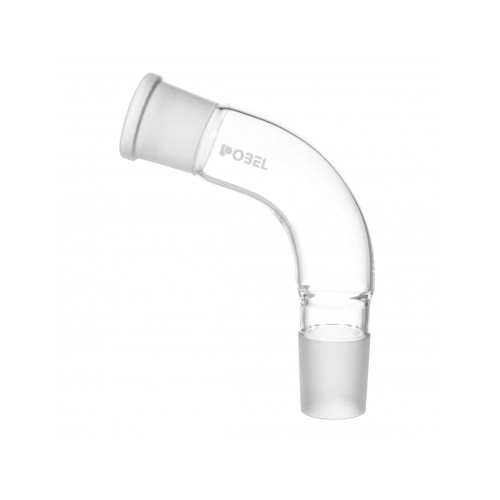Adapter Bent 105° socket14/23,cone14/23
Angle of Bend: 105°
Socket Size: 14/23
Cone Size: 14/23
Material: Borosilicate Glass
Maximum Temperature: 250°C
Length: 120 mm
Outer Diameter: 14 mm
available soon
Adapter Bent 105° socket14/23,cone14/23
You're staring at a bench crammed with glassware, trying to figure out how to fit a condenser without knocking over your stirrer. That's exactly when a bent adapter saves the day. The 105° angle on this socket 14/23, cone 14/23 adapter gives you the clearance to actually work without playing lab equipment Tetris every time you adjust something.
Borosilicate glass (Boro 3.3) construction handles thermal shock from -80°C cryogenic traps straight through to 200°C heating mantles. Precision-ground joints seal tight with minimal grease—way better than cheap adapters that leak under vacuum.
Space-Efficient 105° Bent Adapter for Crowded Fume Hoods
That 105° curve isn't arbitrary. It's the sweet spot between compact footprint and maintaining laminar vapor flow during distillations. Teaching labs routinely fit three extra student setups by swapping straight connectors for angled ones. When you're running a Rotary evaporator R-3001 with limited bench space, every inch matters.
Compare this to an adapter vacuum/inert, gas, 90 degrees, cone 29/32—that sharper 90° angle creates turbulence and needs larger joints for equivalent throughput. The gradual 105° geometry prevents vapor scrambling, which matters when separating compounds with close boiling points.
Compact Setup Solutions with 14/23 Joint Sizing
Both ends sport 14/23 ground glass joints, giving you true bidirectional flexibility. Socket facing up today, cone tomorrow? Just flip it. Organic synthesis groups reconfigure between reflux and distillation modes without hunting for different adapters.
- Vacuum-rated seals: Hermetic down to 0.1 mbar for pharmaceutical GMP work
- Volume capacity: Handles 50mL to 500mL reaction vessels comfortably
- Universal compatibility: Mates with round-bottoms, Claisen adapters, Graham condensers, Dean-Stark traps
- Thermal range: Cryogenic to 500°C without cracking
Need larger volumes? Check the Adapter Distillation 105°, socket 14/23 for bigger receiving vessels. For vacuum transfer with a sidearm port, grab the Adapter vacuum, 105° socket 14/23, cone 14/23 instead—this standard bent adapter doesn't include gas ports.
Condenser Positioning in Limited Workspace Environments
Real talk: bench space costs money. Cramming equipment without clearance is how accidents happen. The angled pathway routes connections around obstacles instead of forcing straight-line configurations that eat three feet of countertop.
Process chemists scale from 100mL to 2L flasks while maintaining manageable footprints using angled adapters strategically. Natural product extraction teams stack these with Dean-Stark traps at angles that let water separate cleanly without fighting gravity.
Collision prevention benefits:
- Reflux systems tuck under overhead mounts without sacrificing stirrer position
- Short-path distillations stay compact when paired with an adapter cone 14/23, free tube length 100mm on receiving end
- Environmental labs create tiered collection systems that don't sprawl horizontally
- Polymer chemists accommodate mechanical stirring while keeping sampling ports accessible
Reducing Horizontal Footprint Without Compromising Performance
The smooth 105° arc maintains laminar flow better than sharp bends, reducing bumping during fractional distillations. Analytical chemists preparing standards notice cleaner cuts between fractions because vapors aren't getting scrambled at abrupt angles.
Materials scientists working with high-boiling solvents like DMF find the gradual curve prevents premature condensation that'd ruin separations. Dead volume stays minimal—the gentle bend prevents product pooling in corners where compounds decompose or get lost.
Practical workspace optimization:
- Vertical stacking: Condensers mount overhead while receiving flasks stay at bench level
- Sightline maintenance: See reaction progress without craning around apparatus
- Equipment coexistence: Overhead stirrers and heating mantles fit without constant repositioning
Pro tip: Keep two of these pre-assembled in opposite orientations with your common setups. You'll save fifteen minutes every reconfiguration, and your joints will thank you for not constantly twisting them apart. The precision grinding means you'll use 30% less joint grease compared to poorly-fitted alternatives.
Leave a review about product
Sign up to our newsletter to get the latest news and updates about our products.

